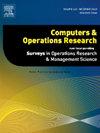Seru scheduling problem with lot streaming and worker transfers: A multi-objective approach
IF 4.1
2区 工程技术
Q2 COMPUTER SCIENCE, INTERDISCIPLINARY APPLICATIONS
引用次数: 0
Abstract
Seru production system (SPS) offers the flexibility of job shop production environments with the efficiency of traditional assembly lines. The SPSs are particularly attractive to industries characterized by high product variety and micro production volumes, and effective utilization of production and workforce resources is a critical challenge for SPSs. This paper addresses the seru scheduling problem with lot streaming and worker transfers for a SPS using a multi-objective approach. To this end, first, a multi-objective mixed-integer linear programming (MILP) model is developed for the minimization of makespan, average flow time, and maximum workload imbalance. Six different algorithms based on non-dominating sorting genetic algorithm II (NSGA-II) are developed, each corresponding to an operational setting dictated by the lot streaming and worker transfers strategies in effect. A design of experiment (DoE) framework is utilized to generate realistic problem instances based on the several controllable factors and their levels. Analysis of comprehensive computational results demonstrates the effectiveness of the proposed algorithm (NS2) in finding high-quality and diversified solutions by simultaneous utilization of lot streaming with variable-sized sublots and worker transfers. The results indicate that the performance improvement achieved by the NS2 ranges between 10% and 20% compared to other algorithms. Furthermore, Analysis of Variance (ANOVA) confirms the significance of the number of workers and number of serus as critical parameters for the design or redesign of SPSs. Drawing on these findings, managerial insights are provided regarding the impact of lot streaming and worker transfers on SPS performance. This study offers practical and theoretical insights for decision-makers seeking to enhance SPS performance and bridge the gap between the conceptual analysis and practical implementation of SPSs.
具有批流和工人转移的Seru调度问题:一个多目标方法
Seru生产系统(SPS)提供了作业车间生产环境的灵活性和传统装配线的效率。SPSs对产品品种多、产量小的行业特别有吸引力,有效利用生产和劳动力资源是SPSs面临的关键挑战。本文采用多目标方法研究了具有批流和工人转移的SPS的seru调度问题。为此,首先建立了一个多目标混合整数线性规划(MILP)模型,以最小化完工时间、平均流程时间和最大工作负载不平衡。基于非支配排序遗传算法II (NSGA-II)开发了六种不同的算法,每种算法对应于由有效的批次流和工人转移策略决定的操作设置。利用实验设计(DoE)框架,基于多个可控因素及其水平生成现实问题实例。综合计算结果分析表明,本文提出的算法(NS2)能够通过同时利用具有可变大小子批次和工人转移的批次流来寻找高质量和多样化的解决方案。结果表明,与其他算法相比,NS2的性能提升幅度在10% ~ 20%之间。此外,方差分析(ANOVA)证实了工人数量和血清数量作为SPSs设计或重新设计的关键参数的重要性。根据这些发现,提供了关于批次流和工人转移对SPS绩效的影响的管理见解。本研究为寻求提高SPS绩效的决策者提供了实践和理论见解,并弥合了SPS概念分析与实际实施之间的差距。
本文章由计算机程序翻译,如有差异,请以英文原文为准。
求助全文
约1分钟内获得全文
求助全文
来源期刊

Computers & Operations Research
工程技术-工程:工业
CiteScore
8.60
自引率
8.70%
发文量
292
审稿时长
8.5 months
期刊介绍:
Operations research and computers meet in a large number of scientific fields, many of which are of vital current concern to our troubled society. These include, among others, ecology, transportation, safety, reliability, urban planning, economics, inventory control, investment strategy and logistics (including reverse logistics). Computers & Operations Research provides an international forum for the application of computers and operations research techniques to problems in these and related fields.
 求助内容:
求助内容: 应助结果提醒方式:
应助结果提醒方式:


